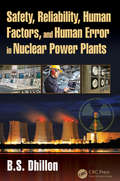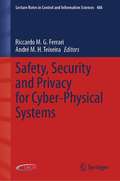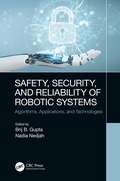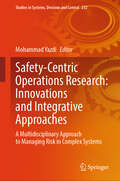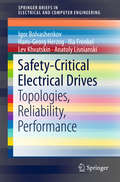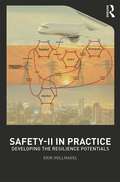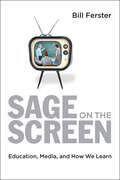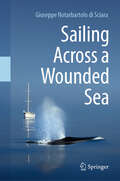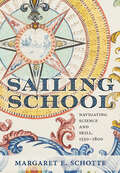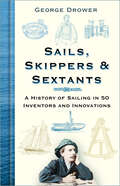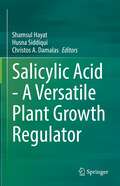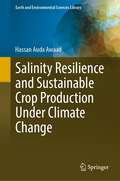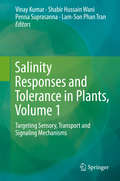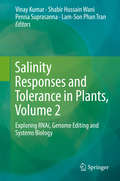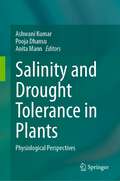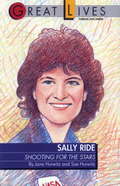- Table View
- List View
Safety, Reliability, Human Factors, and Human Error in Nuclear Power Plants
by B.S. DhillonEach year billions of dollars are being spent in the area of nuclear power generation to design, construct, manufacture, operate, and maintain various types of systems around the globe. Many times these systems fail due to safety, reliability, human factors, and human error related problems. The main objective of this book is to combine nuclear power plant safety, reliability, human factors, and human error into a single volume for those individuals that work closely during the nuclear power plant design phase, as well as other phases, thus eliminating the need to consult many different and diverse sources in obtaining the desired information.
Safety, Security and Privacy for Cyber-Physical Systems (Lecture Notes in Control and Information Sciences #486)
by Riccardo M. G. Ferrari André M. H. TeixeiraThis book presents an in-depth overview of recent work related to the safety, security, and privacy of cyber-physical systems (CPSs). It brings together contributions from leading researchers in networked control systems and closely related fields to discuss overarching aspects of safety, security, and privacy; characterization of attacks; and solutions to detecting and mitigating such attacks. The book begins by providing an insightful taxonomy of problems, challenges and techniques related to safety, security, and privacy for CPSs. It then moves through a thorough discussion of various control-based solutions to these challenges, including cooperative fault-tolerant and resilient control and estimation, detection of attacks and security metrics, watermarking and encrypted control, privacy and a novel defense approach based on deception. The book concludes by discussing risk management and cyber-insurance challenges in CPSs, and by presenting the future outlook for this area of research as a whole. Its wide-ranging collection of varied works in the emerging fields of security and privacy in networked control systems makes this book a benefit to both academic researchers and advanced practitioners interested in implementing diverse applications in the fields of IoT, cooperative autonomous vehicles and the smart cities of the future.
Safety, Security, and Reliability of Robotic Systems: Algorithms, Applications, and Technologies
by Nadia Nedjah Brij B. GuptaWith the increasing demand of robots for industrial and domestic use, it becomes indispensable to ensure their safety, security, and reliability. Safety, Security and Reliability of Robotic Systems: Algorithms, Applications, and Technologies provides a broad and comprehensive coverage of the evolution of robotic systems, as well as industrial statistics and future forecasts. First, it analyzes the safety-related parameters of these systems. Then, it covers security attacks and related countermeasures, and how to establish reliability in these systems. The later sections of the book then discuss various applications of these systems in modern industrial and domestic settings. By the end of this book, you will be familiarized with the theoretical frameworks, algorithms, applications, technologies, and empirical research findings on the safety, security, and reliability of robotic systems, while the book’s modular structure and comprehensive material will keep you interested and involved throughout. This book is an essential resource for students, professionals, and entrepreneurs who wish to understand the safe, secure, and reliable use of robotics in real-world applications. It is edited by two specialists in the field, with chapter contributions from an array of experts on robotics systems and applications.
Safety-Centric Operations Research: A Multidisciplinary Approach to Managing Risk in Complex Systems (Studies in Systems, Decision and Control #232)
by Mohammad YazdiThis book offers a pioneering exploration into the integration of safety considerations with operations research, providing a vital toolkit for enhancing decision-making processes in hazardous industries. It delivers comprehensive insights and innovative methodologies to foster safety-centric planning and operations across various sectors. As the complexities of modern industries increase, so does the potential for operational risks. This book addresses this challenge by merging rigorous safety analysis with the quantitative sophistication of operations research. This book aims to create safer working environments and more resilient operational frameworks. The book is divided into several key sections, each focusing on different aspects of operations research applied to safety. Initial chapters lay a theoretical foundation, discussing mathematical models and statistical methods that prioritize safety. Subsequent sections delve into specific applications within supply chain management, transportation logistics, and production planning, illustrating how these methods can be practically applied to reduce risks and enhance operational safety. Advanced topics covered include the application of machine learning and artificial intelligence to predict and mitigate potential hazards and the use of simulation techniques to model and manage operational risks. Real-world case studies are presented to show the practical implementation of these theories in industries such as manufacturing, health care, and energy, providing readers with actionable insights and proven strategies. Additionally, the book examines the cultural and behavioral aspects of safety in operations, emphasizing the importance of building a robust safety culture and integrating human factors into safety planning. Ethical and regulatory dimensions are also explored to guide practitioners in navigating the complex legal landscapes that govern safety in various industries. This book is an essential resource for students, researchers, and professionals in operations research and management, especially those involved in planning and executing operations in safety-critical sectors. It is particularly relevant for those who aim to blend technical proficiency with practical safety solutions to solve real-world challenges in operations&’ management.
Safety-Critical Electrical Drives: Topologies, Reliability, Performance (SpringerBriefs in Electrical and Computer Engineering)
by Ilia Frenkel Anatoly Lisnianski Igor Bolvashenkov Hans-Georg Herzog Lev KhvatskinThis book focuses on one of the most important aspects of electrical propulsion systems – the creation of highly reliable safety-critical traction electrical drives. It discusses the methods and models for analysis and optimization of reliability and fault tolerance indices, based on which, it proposes and assesses methods for improving the availability, fault tolerance and performance of traction electric drives.
Safety-I and Safety-II: The Past and Future of Safety Management
by Erik HollnagelSafety has traditionally been defined as a condition where the number of adverse outcomes was as low as possible (Safety-I). From a Safety-I perspective, the purpose of safety management is to make sure that the number of accidents and incidents is kept as low as possible, or as low as is reasonably practicable. This means that safety management must start from the manifestations of the absence of safety and that - paradoxically - safety is measured by counting the number of cases where it fails rather than by the number of cases where it succeeds. This unavoidably leads to a reactive approach based on responding to what goes wrong or what is identified as a risk - as something that could go wrong. Focusing on what goes right, rather than on what goes wrong, changes the definition of safety from ’avoiding that something goes wrong’ to ’ensuring that everything goes right’. More precisely, Safety-II is the ability to succeed under varying conditions, so that the number of intended and acceptable outcomes is as high as possible. From a Safety-II perspective, the purpose of safety management is to ensure that as much as possible goes right, in the sense that everyday work achieves its objectives. This means that safety is managed by what it achieves (successes, things that go right), and that likewise it is measured by counting the number of cases where things go right. In order to do this, safety management cannot only be reactive, it must also be proactive. But it must be proactive with regard to how actions succeed, to everyday acceptable performance, rather than with regard to how they can fail, as traditional risk analysis does. This book analyses and explains the principles behind both approaches and uses this to consider the past and future of safety management practices. The analysis makes use of common examples and cases from domains such as aviation, nuclear power production, process management and health care. The final chapters explain the theoret
Safety-II in Practice: Developing the Resilience Potentials
by Erik HollnagelSafety-I is defined as the freedom from unacceptable harm. The purpose of traditional safety management is therefore to find ways to ensure this ‘freedom’. But as socio-technical systems steadily have become larger and less tractable, this has become harder to do. Resilience engineering pointed out from the very beginning that resilient performance - an organisation’s ability to function as required under expected and unexpected conditions alike – required more than the prevention of incidents and accidents. This developed into a new interpretation of safety (Safety-II) and consequently a new form of safety management. Safety-II changes safety management from protective safety and a focus on how things can go wrong, to productive safety and a focus on how things can and do go well. For Safety-II, the aim is not just the elimination of hazards and the prevention of failures and malfunctions but also how best to develop an organisation’s potentials for resilient performance – the way it responds, monitors, learns, and anticipates. That requires models and methods that go beyond the Safety-I toolbox. This book introduces a comprehensive approach for the management of Safety-II, called the Resilience Assessment Grid (RAG). It explains the principles of the RAG and how it can be used to develop the resilience potentials. The RAG provides four sets of diagnostic and formative questions that can be tailored to any organisation. The questions are based on the principles of resilience engineering and backed by practical experience from several domains. Safety-II in Practice is for both the safety professional and academic reader. For the professional, it presents a workable method (RAG) for the management of Safety-II, with a proven track record. For academic and student readers, the book is a concise and practical presentation of resilience engineering.
Sage on the Screen: Education, Media, and How We Learn (Tech.edu: A Hopkins Series on Education and Technology)
by Bill FersterA critical look at the success of film, video, television, and the Internet in education.Since the days of Thomas Edison, technology has held the promise of lowering the cost of education. The fantasy of leveraging a fixed production cost to reach an unlimited number of consumers is an enticing economic proposition, one that has been repeatedly attempted with each new media format, from radio and television to MOOCs, where star academics make online video lectures available to millions of students at little cost. In Sage on the Screen, Bill Ferster explores the historical, theoretical, and practical perspectives of using broadcast media to teach by examining a century of efforts to use it at home and in the classroom. Along the way, he shares stories from teachers, administrators, entrepreneurs, and innovators who promoted the use of cutting-edge technology—while critically evaluating their motives for doing so.Taking a close look at the origins of various media forms, their interrelatedness, and their impact on education thus far, Ferster asks why broadcast media has been so much more successful at entertaining people than it has been at educating them. Accessibly written and full of explanatory art, Sage on the Screen offers fresh insight into the current and future uses of instructional technology, from K12 through non-institutionally-based learning.
Sailboat (How It's Built)
by Rebecca J. StanboroughKids are fascinated by how things are constructed, especially big things!This brand-new STEM (science, technology, engineering, and mathematics) series will take readers on visits to various work sites so they can see exactly How It’s Built! Kids will follow along as a small group of fictional characters get to find out exactly what it takes to build things that they probably see all the time, like bridges, houses, boats, and cars, to things that they might dream of being inside, like skyscrapers and rockets.
Sailing Across a Wounded Sea
by Giuseppe Notarbartolo di SciaraThe capacity of humans to destroy their environment is playing out like a Greek tragedy in the Mediterranean Sea. After having coexisted with a diversity of marine animals throughout their history, humans have broken the balance in recent decades, and the survival of countless marine creatures is now increasingly uncertain. However, unlike in classical tragedies, real-life entities are not necessarily doomed by their fate, and there must be hope to turn the tide in nature’s favour. Lack of concrete conservation action might be simply due to a lack of awareness: how can we feel sad about a loss if we don’t know what we are losing? “Sailing Across a Wounded Sea” is the story of an ideal journey around the Mediterranean to meet its non-human inhabitants, consisting of real episodes collected over half a century as the author observed real animals, exchanged views with a variety of contacts, and argued for such views in the policy arena. Encountering whales, dolphins,seals and rays in their habitat and on their terms will hopefully contribute to building up in readers a collective commitment to help secure a future for these species. A future where they are allowed to flourish as they were meant to - had humans never trod so heavily on the sea’s delicate ecological balance and the interwoven natural processes. Giuseppe Notarbartolo di Sciara has been involved for a lifetime in protecting marine biodiversity in various capacities – as a scientist, civil servant, advocate and sailor. Having studied in California and worked with whales, dolphins and sharks worldwide, he returned to the Mediterranean in 1985, keen on using his acquired tools to discover more about the ancient sea's natural history. Here, he described small but vibrant populations of fin and sperm whales, along with various species of dolphins, manta rays and the monk seal. At the same time, seeing the Mediterranean’s progressive degradation at the hands of humans, he felt a surge of rebellion against this squandering of natural values, and wished to raise awareness of the existence of these marine natural treasures and the risk of losing them. “Drawing from decades of first-hand experiences, in ‘Sailing Across a Wounded Sea’ Giuseppe Notarbartolo di Sciara offers a compelling narrative that interweaves the beauty of the Mediterranean Sea’s non-human inhabitants with the challenges they face due to human activity. As he reflects on his journey, the author underscores the imperative for collective action and the need for heightened awareness and proactive conservation measures to protect our oceans. ‘Sailing Across a Wounded Sea’ serves not only as a captivating voyage but also as a sobering call to responsibility. Join Giuseppe Notarbartolo di Sciara on this insightful expedition and discover the profound significance of preserving our marine ecosystems for future generations.” —Peter Thomson, United Nations Secretary General’s Special Envoy for the Ocean “The Mediterranean, the cradle of civilisation, is a sea steeped in history. From Apollon and Artemis to Pythagoras and Hercules, names in this book summon up images of civilisations past and lost. The greatest Greek philosopher of them all, Aristotle, is also regarded as the father of marine biodiversity, stemming from his research conducted on Lesbos Island. And yet this ancient world, familiar to so many, is under threat. In this book Notarbartolo di Sciara takes us on a modern-day odyssey through these waters, based on over 50 years of personal observations. He reminds us of the impact of the progressive footprint of human action and endeavour, which has spread out across the whole sea, changing, and depleting its beauty and splendour. His voyage paints a picture not just of what is at stake but also of the potential the future can hold if we all work together to give nature a breathing space, to allow it to restore and recover. In our modern world, where we h
Sailing School: Navigating Science and Skill, 1550-1800 (Information Cultures)
by Margaret E. SchotteHands-on science in the Age of Exploration.Winner of the John Lyman Book Award in Naval and Maritime Science and Technology by the North American Society for Oceanic History and the Leo Gershoy Prize by the American Historical AssociationThroughout the Age of Exploration, European maritime communities bent on colonial and commercial expansion embraced the complex mechanics of celestial navigation. They developed schools, textbooks, and instruments to teach the new mathematical techniques to sailors. As these experts debated the value of theory and practice, memory and mathematics, they created hybrid models that would have a lasting impact on applied science. In Sailing School, a richly illustrated comparative study of this transformative period, Margaret E. Schotte charts more than two hundred years of navigational history as she investigates how mariners solved the challenges of navigating beyond sight of land. She begins by outlining the influential sixteenth-century Iberian model for training and certifying nautical practitioners. She takes us into a Dutch bookshop stocked with maritime manuals and a French trigonometry lesson devoted to the idea that "navigation is nothing more than a right triangle." The story culminates at the close of the eighteenth century with a young British naval officer who managed to keep his damaged vessel afloat for two long months, thanks largely to lessons he learned as a keen student.This is the first study to trace the importance, for the navigator's art, of the world of print. Schotte interrogates a wide variety of archival records from six countries, including hundreds of published textbooks and never-before-studied manuscripts crafted by practitioners themselves. Ultimately, Sailing School helps us to rethink the relationship among maritime history, the Scientific Revolution, and the rise of print culture during a period of unparalleled innovation and global expansion.
Sails, Skippers and Sextants: A History of Sailing in 50 Inventors and Innovations
by George Drower‘The inventions, the innovations, the stories, the surprises. A combination of history, reference and entertainment – something for every seafarer and many others too.’ - Vice Admiral Sir Tim Laurence.People have been sailing for thousands of years, but we’ve come some distance from longboats and clippers. How did we arrive here?In fifty tales of inventors and innovations, Sails, Skippers and Sextants looks at the history of one of our most enjoyable pastimes, from the monarch who pioneered English yachting to the engineer who invented sailboards. The stories are sometimes inspiring, usually amusing and often intriguing – so grab your lifejacket, it’s going to be quite an adventure.
Salesforce End-to-End Implementation Handbook: A practitioner's guide for setting up programs and projects to deliver superior business outcomes
by Kristian Margaryan JorgensenPacked with practical examples, case studies, and proven recommendations, this handbook helps you manage enterprise-grade Salesforce programsKey FeaturesExplore the end-to-end Salesforce implementation lifecycle with templates and practical examplesDiscover common issues and strategies for mitigation and preventionWork with checklists to assess the state of your Salesforce implementation in each phasePurchase of the print or Kindle book includes a free PDF eBookBook DescriptionWith ever-growing digital transformation programs involving Salesforce, there is a greater need for a comprehensive overview of the phases and activities specific to Salesforce implementations. This book will act as a detailed guide for your Salesforce implementation journey, including common issues and pitfalls to mitigate and prevent errors. The Salesforce End-to-End Implementation Handbook starts with the pre-development phase. Here you'll understand how to define the vision and nature of your project, determine your change management strategy and delivery methodology, learn to build a business case for your project, get insights on engaging with Salesforce and implementation partners, and learn to establish a governance framework. As you progress, you'll gain insights on the necessary activities, milestones, and common issues faced in salesforce implementation, along with strategies to mitigate them. At the end of each section, you'll find evaluation checklists to assess the state of your Salesforce implementation. By the end of this book, you'll be well-equipped to set up Salesforce projects and programs effectively and deliver maximum ROI.What you will learnDiscover the critical activities in Salesforce implementationAddress common issues faced in implementing SalesforceExplore appropriate delivery methodologyUnderstand the importance of a change management strategyGovern Salesforce implementation through all its phasesGain insights on key activities in the continuous improvement phaseLeverage customer 360 for analytics, AI and automationWho this book is forThis book is for salesforce consultants, architects, project/program managers, delivery leaders for salesforce implementation, or product owners- planning to implement Salesforce or already implementing Salesforce for their organizations.If you are switching to a role in salesforce development, this book will act as a guide on what to expect on the job and how to ace it. Familiarity with basic business, CRM, and project management concepts is required.
Salesforce End-to-End Implementation Handbook: A practitioner's guide for setting up programs and projects to deliver superior business outcomes
by Kristian Margaryan JørgensenPacked with practical examples, case studies, and proven recommendations, this handbook helps you manage enterprise-grade Salesforce programsKey FeaturesExplore the end-to-end Salesforce implementation lifecycle with templates and practical examplesDiscover common issues and strategies for mitigation and preventionWork with checklists to assess the state of your Salesforce implementation in each phasePurchase of the print or Kindle book includes a free PDF eBookBook DescriptionWith ever-growing digital transformation programs involving Salesforce, there is a greater need for a comprehensive overview of the phases and activities specific to Salesforce implementations. This book will act as a detailed guide for your Salesforce implementation journey, including common issues and pitfalls to mitigate and prevent errors. The Salesforce End-to-End Implementation Handbook starts with the pre-development phase. Here you’ll understand how to define the vision and nature of your project, determine your change management strategy and delivery methodology, learn to build a business case for your project, get insights on engaging with Salesforce and implementation partners, and learn to establish a governance framework. As you progress, you’ll gain insights on the necessary activities, milestones, and common issues faced in Salesforce implementation, along with strategies to mitigate them. At the end of each section, you’ll find evaluation checklists to assess the state of your Salesforce implementation. By the end of this book, you’ll be well-equipped to set up Salesforce projects and programs effectively and deliver maximum ROI.What you will learnDiscover the critical activities in Salesforce implementationAddress common issues faced in implementing SalesforceExplore appropriate delivery methodologyUnderstand the importance of a change management strategyGovern Salesforce implementation through all its phasesGain insights on key activities in the continuous improvement phaseLeverage customer 360 for analytics, AI and automationWho this book is forThis book is for Salesforce consultants, architects, project/program managers, delivery leaders for Salesforce implementation, or product owners- planning to implement Salesforce or already implementing Salesforce for their organizations. If you are switching to a role in Salesforce development, this book will act as a guide on what to expect on the job and how to ace it. Familiarity with basic business, CRM, and project management concepts is required.
Salicylic Acid - A Versatile Plant Growth Regulator
by Shamsul Hayat Husna Siddiqui Christos A. DamalasPhytohormones are known to affect the growth and development of plant directly as well as indirectly. Salicylic acid (SA) is a phenolic phytohormone which induces systemic resistance in plants and also regulates defence responses. The derivatives of SA also play an important role in the regulation of various physiological and developmental processes in plants under normal and stressful environmental conditions. SA regulates seed germination, photosynthesis, ethylene biosynthesis, enzyme activities, nutrition, flowering, legume nodulation and overall growth and development of plant. Recently, advancement in elucidating the specific pathways of SA signal transduction has been noticed which helps in understanding the expression of specific genes associated with different developmental programs. The horizon of SA-mediated regulation of various physiological processes has also expanded, and various studies enumerating the efficacy of exogenously applied SA in practical agriculture have also been documented. Therefore, information regarding such recent developments needs to be compiled in the form of a book. This book aims to provide a collective information regarding SA which makes it a versatile plant growth regulator. The chapters included both theoretical and practical aspects that could be of immense use for researches and possible significant developments in future. It is intended that this book will be a help for students, teachers, and researchers, in understanding the relation between the phytohormone and agricultural sciences.
Saline Soil-based Agriculture by Halotolerant Microorganisms
by Manoj Kumar Vivek Kumar Hassan EtesamiThis book discusses the role of salt in current agricultural approaches, including the low salt tolerance of agricultural crops and trees, impact of saline soils, and salt-resistant plants. Halophytes are extremely salt tolerant plants, which are able to grow and survive under salt at concentrations as high as 5 g/l by maintaining negative water potential. The salt-tolerant microbes inhabiting the rhizospheres of halophytes may contribute to their salt tolerance, and the rhizospheres of halophytic plants provide an ideal opportunity for isolating various groups of salt-tolerant microbes that could enhance the growth of different crops under salinity stress. The book offers an overview of salt-tolerant microbes' ability to increase plant tolerance to salt to facilitate plant growth, the potential of the halophytes’ rhizospheres as a reservoir of beneficial salt-tolerant microbes, their future application as bio-inoculants in agriculture and a valuable resource for an alternative way of improving crop tolerance to salinity and promoting saline soil-based agriculture. This special collection of reviews highlights some of the recent advances in applied aspects of plant (halophytes)-microbe interactions and their contribution towards eco-friendly approaches saline soil-based agriculture.
Saline and Alkaline Soils in Latin America: Natural Resources, Management and Productive Alternatives
by Edith Taleisnik Raúl S. LavadoThis book provides the first comprehensive overview of saline and alkaline soils in Latin America, known for having one of the most extensive surface of salt-affected soils in the world. It is organized along two main axes: soils and vegetation. The book discusses the occurrence of such soils in the region, focusing mainly in management strategies for their sustainable use, and it presents accounts of natural vegetation and crops in the various environments of the region. Social impacts of such conditions and ongoing projects to overcome them are considered. Likewise, the book highlights physiological mechanisms that are responsible for the negative effects these soils exert on crops and forest resources and determine vegetation distribution in them. Plant breeding challenges and new perspectives for such environments are discussed. Technologies such as irrigation and drainage are included. The readership includes soil and plant scientists, as well as policy makers.
Salinity Resilience and Sustainable Crop Production Under Climate Change (Earth and Environmental Sciences Library)
by Hassan Auda AwaadThe book provides a comprehensive review of the rapidly expanding and includes in-depth discussions on salinity resilience, sustainable production under climate change, how do plants resilience saline conditions?, Beside Genetic Diversity and inheritance of resistance to Salinity. Furthermore, covers a vast array of special topics and applications illustrating the wide use recent approach of techniques and measurements of assessing genotypes for salinity resilienceThis book has been prepared and supported by recent references and statistics with tables and colourful figures to deliver recent advances to the audience of lower and upper undergraduate, and professional/Practitioner researchers at universities and research centers in the fields of crop breeding and production, physiology, genetics, molecular biology and biotechnology, and allied fields such as agro ecology, sustainable agriculture, climate-resilient agriculture.
Salinity Responses and Tolerance in Plants, Volume 1: Targeting Sensory, Transport And Signaling Mechanisms
by Vinay Kumar Penna Suprasanna Lam-Son Phan Tran Shabir Hussain WaniSoil salinity is a key abiotic-stress and poses serious threats to crop yields and quality of produce. Owing to the underlying complexity, conventional breeding programs have met with limited success. Even genetic engineering approaches, via transferring/overexpressing a single ‘direct action gene’ per event did not yield optimal results. Nevertheless, the biotechnological advents in last decade coupled with the availability of genomic sequences of major crops and model plants have opened new vistas for understanding salinity-responses and improving salinity tolerance in important glycophytic crops. Our goal is to summarize these findings for those who wish to understand and target the molecular mechanisms for producing salt-tolerant and high-yielding crops. Through this 2-volume book series, we critically assess the potential venues for imparting salt stress tolerance to major crops in the post-genomic era. Accordingly, perspectives on improving crop salinity tolerance by targeting the sensory, ion-transport and signaling mechanisms are presented here in volume 1. Volume 2 will focus on the potency of post-genomic era tools that include RNAi, genomic intervention, genome editing and systems biology approaches for producing salt tolerant crops.
Salinity Responses and Tolerance in Plants, Volume 2: Exploring RNAi, Genome Editing and Systems Biology
by Vinay Kumar Penna Suprasanna Lam-Son Phan Tran Shabir Hussain WaniSoil salinity is a key abiotic-stress and poses serious threats to crop yields and quality of produce. Owing to the underlying complexity, conventional breeding programs have met with limited success. Even genetic engineering approaches, via transferring/overexpressing a single ‘direct action gene’ per event did not yield optimal results. Nevertheless, the biotechnological advents in last decade coupled with the availability of genomic sequences of major crops and model plants have opened new vistas for understanding salinity-responses and improving salinity tolerance in important glycophytic crops. Our goal is to summarize these findings for those who wish to understand and target the molecular mechanisms for producing salt-tolerant and high-yielding crops. Through this 2-volume book series, we critically assess the potential venues for imparting salt stress tolerance to major crops in the post-genomic era. Accordingly, perspectives on improving crop salinity tolerance by targeting the sensory, ion-transport and signaling mechanisms were presented in Volume 1. Volume 2 now focuses on the potency of post-genomic era tools that include RNAi, genomic intervention, genome editing and systems biology approaches for producing salt tolerant crops.
Salinity and Drainage in San Joaquin Valley, California
by Andrew C. Chang Deborah Brawer SilvaThis book documents the history of irrigated agriculture and drainage in the San Joaquin Valley, and describes the hydrology and biogeochemical processes of salts and selenium, remediation technologies for salts and trace elements and policy and management options. The contents are comprised of fourteen chapter-length independent treatises, each depicting with fresh perspective a distinctive salinity drainage topic. The opening chapters detail the evolution of irrigated agriculture, and depict the geochemical and hydrological processes that define the San Joaquin Valley, including the physics, chemistry, and biology attributes that impact water management policies and strategies. Next, the contributors address the biogeochemistry of selenium, the role of plants in absorbing it from soils, and the processes involved in retaining and concentrating dissolved salts in drainage water. Further chapters describe on-farm and plot-level irrigation provisions to reduce agricultural drainage outputs and examine their effects on plant performance. This volume offers realistic policy analysis of water management options for irrigated agriculture in the Valley and assesses their respective outcomes, if implemented. Also included is an international perspective on the sustainability of irrigated agriculture there.
Salinity and Drought Tolerance in Plants: Physiological Perspectives
by Ashwani Kumar Anita Mann Pooja DhansuThis edited book is a comprehensive collection of scientific research on different plants under drought and salt stress conditions. The main focus of this book is to elaborate on the mechanisms being operative in plants under stress and how various biological factors mitigate the adverse effects for better plant productivity. This book covers all physiological, biochemical, and molecular mechanisms operating under drought and saline stresses. The current status and impact of drought and salinity on various crop plants have been elaborated on in different chapters. Agricultural lands are either turning barren or becoming more saline and drought-prone with increasing temperatures, decreasing water tables, untimely rainfall, and other environmental factors. In India, salt-affected soils occupy an area of about 6.73 million ha of which saline and sodic soils constitute roughly 40 and 60%, respectively. All these factors individually or cumulatively, affect the plant growth and development and hence, the crop productivity with the monetary loss. The inbuilt plant's ability with modified/acclimatized mechanisms has been described in various chapters with step-wise descriptions. The role of various plant growth-promoting agents including nano-particles, micro-organisms, metabolites or phytohormones, etc in mitigating adverse effects of drought and salinity has been explained precisely. Updated information on the use of speed breeding, proteomics, epigenetics, and transcriptomics in different crops along with high throughput technologies is included for the cross-talk of various network mechanisms. This book is helpful for the readers in knowing salinity and drought through the physiological, biochemical and genetic, and molecular levels to understand plant behaviour under stress conditions. Also, the book serves as additional reading material for undergraduate and graduate students of agriculture, plant physiology, biochemistry, forestry, and environmental sciences. National and international agricultural scientists and policymakers will also find this to be a useful read.
Salinity and Sodicity: A Growing Global Challenge to Food Security, Environmental Quality and Soil Resilience (ASA, CSSA, and SSSA Books)
by Sharon A. Clay David E. Clay, Thomas M. DeSutter Thomas M. DeSutter Thandiwe NleyaExplore the growing problem of soil salinity and sodicity and its impact on the environment, profitability, the human population, and soil resilience In Salinity and Sodicity: A Global Challenge to Food Security, Environmental Quality, and Soil Resilience, a team of distinguished educators delivers an expert discussion of salinity and sodicity management. This book is designed to improve the problem-solving capabilities of students, soil health professionals, certified crop advisors, and other practicing professionals in this area. In addition to an introduction to the causes of a rapidly growing problem, Salinity and Sodicity explores different measurement techniques, provides answers to common questions, provides potential solutions in a way that’s appropriate for introductory classes on soil salinity and sodicity management. It’s an ideal reference manual for professionals, as well as an effective tool for classrooms and crop advisor workshops. Readers will also find: A thorough introduction to the use of supplemental irrigation and the impact of salts on the environmentComprehensive explorations of the economic considerations for farming problematic soilsPractical discussions of the effects of salinity and sodicity on erosion and greenhouse gas emissionsPractical case studies, problem sets, and an instructor answer key Perfect for undergraduate, graduate, and doctoral students and certified and practicing soil professionals and advisors, Salinity and Sodicity will also benefit industry and academic researchers with an interest in soil salinity and sodicity in dryland regions.
Sally Ride
by Sue HurwitzSally RideShooting for the StarsAstronaut Dr. Sally Ride took a deep breath and nervously waited as the powerful engines of the Space Shuttle Challenger roared to life. This was the most frightening, yet exciting moment of Sally's life! She was determined to prove that an American woman could perform in space as well as a man.Countdown to History!Sally Ride: Shooting for the Stars profiles the life of America's first woman astronaut to fly in space. Jain Sally's astronaut training as she learns to fly jets, practices sea rescue missions, and floats weightlessly in a special "zero gravity" aircraft. Witness her breathtaking view of Earth from 184 miles out in space while traveling aver 17,400 miles per hour! Then dare to share her dream of joining NASA's astronaut program.From the Trade Paperback edition.
Sally Ride: A Space Biography
by Barbara KramerOn the morning of June 18, 1983, the United States sent its first woman -- Sally Ride -- into space. The book tells the story of Sally Ride, from her youth through her astronaut training. As a mission specialist, she conducted research on pharmaceuticals and the use of the new shuttle's robot arm. The book also discusses her career as a teacher and researcher after retiring from NASA.
